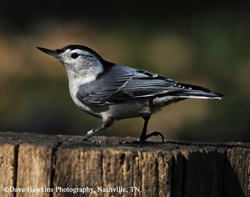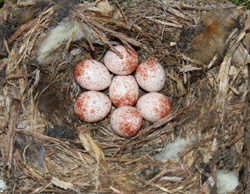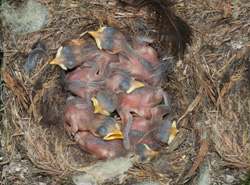White-breasted Nuthatch
Download this page with nest box design (PDF)

Among the species in Sittadae family, the White-breasted Nuthatch is the largest and most common in Tennessee. It is small, yet conspicuous, because of its habit of creeping headfirst down tree trunks and around branches, stopping to crane its neck toward the horizontal, then continuing to forage on the bark crevices. This is a common visitor to feeders and will occasionally nest in nest boxes.
Jump to White-breasted Nuthatch Nest Box Design
Description/Identification see PHOTOS
A small bird with a large head, very short neck, and long, narrow bill. Blue-gray on the back, white face with a black cap and neck that make it look like it is wearing a hood. The breast is white and the flanks are rusty as are the undertail coverts.
Habitat
The White-breasted Nuthatch is found in open woodlands with mature deciduous trees. It is common in suburbs and urban parks with large trees.
Diet
It eats insect larvae and spiders, but also seeds and nuts.
Breeding and Nesting
In Tennessee, breeding activity begins in late winter in the bird’s permanent territory when the male begins to sing and display for its mate. The female selects a natural cavity, sometimes excavating with her sharp bill to increase the size of the entrance hole. She builds the nest, lining the cavity with fur, twigs, and feathers, then making a cup of grass or shredded tree bark. She may use this nest in subsequent years.
Clutch size: 5-10 creamy or pinkish white eggs speckled with reddish brown
Incubation period: Female incubates for 12-14 days and is often fed by her mate. Nestlings fledge after 13-15 days and often remain with their parents until the fall.
Song/calls
Distinctive, and loud nasal “wha, wha, wha. Call note: quick “yank, yank,yank”
Listen to song HERE
Fascinating Facts
- Nuthatches gather and store nuts and seeds, jamming them into tree bark and hammer or "hatch" the food open with their bills at a later time.
- The reasons nuthatches forage by climbing down trees are not fully known, but it may be that they can spot prey hidden from creepers, woodpeckers, and other upward-facing feeders.


White-breasted Nuthatch eggs (left) and young (right). Photos by James Hurt.
Nest Box for White-breasted Nuthatch
Preferred box design for White-breasted Nuthatch is slightly smaller than the NABS Eastern Bluebird box with a 1 ¼ inch entrance hole. This box design may also be used by Carolina Chickadees, Tufted Titmice, House Wrens, and Prothonotary Warblers.
White-breasted Nuthatch nest box design PDF
Nest Box
• Use natural, uncoated wood such as cedar or redwood which are more durable than pine or exterior plywood. Use at least ¾ inch boards.
• Make corner opening on the floor bottom of the box to allow drainage and facilitate ventilation
• Never include an under-the-hole perch.
• The roof should provide sufficient overhang beyond the box entrance or vent holes to protect the birds from the elements.
• The roof should have a minimum of ½ inch overhang at the back.
• The nest box must have watertight construction at all seams.
• Cross ventilation is strongly recommended.
• Include one hinged, side panel that opens for easy monitoring and cleaning.
Box Placement
To attract White-breasted Nuthatch, place your box in a more wooded area than recommended for Eastern Bluebirds. Place the box near woods, shrubs, and thickets, which are used for foraging and hiding from predators. Farms or barnyards where animals are fed are not recommended sites for boxes because these are attractive to House Sparrows. Avoid placing your box where pesticides or herbicides are used.
The nest box should be mounted on a ½" to ¾" electrical conduit post placed over a 3 to 4 ft. piece of rebar. Both materials are available at hardware stores. Pound the rebar into the ground and slide the post over it, making sure that it is solid and steady. Mounting the box on a tree or fence post is not recommended.
Mount the box so that the entrance hole is about 5 ft. from the ground and facing, if possible, to the east, away from direct summer afternoon sun and from north winds that may drive rain into the box. A tree or shrub that is within 100 feet of the box will provide a perch for the adults and a safe spot to land for the fledglings' first flight. If you plan to put up multiple boxes in an area, we recommend placing boxes at least 100 yards apart to reduce competition between White-breasted Nuthatch and other species.
Install a baffle to keep snakes, raccoons and other predators out of the nest.
Squirrels or woodpeckers sometimes damage the entrance hole, making it larger and allowing undesirable species to enter the box. This can be resolved by placing a copper or other metal hole- guard (available at hardware or wild bird retailers) over the damaged hole. A block of 1.5" hardwood with an entrance hole made and placed over the original hole will also work.
Monitoring Your Box
To prevent doing more harm than good, do not install a box if you do not plan to monitor it. Check the box once a week during the nesting season to monitor status of bluebirds or other native nesting species, check for leaks and damage on the box, and provide you with a wonderful education. Keep in mind that even the perfectly built and placed box may not attract a breeding pair the first year. If after two years of not having native birds nesting in your box, you may want to move it to another site.
Monitoring tips:
-Research to recognize the eggs and nests of other species, especially House Sparrows
-Check the box only on a warm, dry day.
-On your day to check the box, try to observe activity of the adults and approach the box while they are away.
If they are present, don't worry that they will desert the nest. They may fly to a perch to watch you, and you may receive a few scoldings from them, but they will return when you leave the area.
-Approach the box quietly.
-Check for ants or other parasites.
-Remove and destroy House Sparrow eggs and nests.
-To prevent premature fledging, do not open the box after 12 days from the time the nestlings hatch.
-Remove and dispose of the nest in the trash soon after the nestlings have fledged. They will not return to the nest and the adults will build another, cleaner nest for the next brood.
-Keep records of the activity in your box.





















